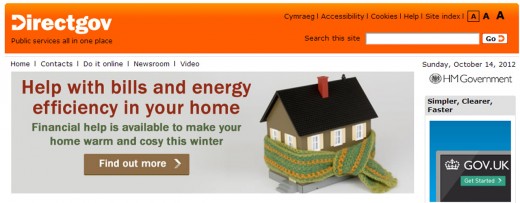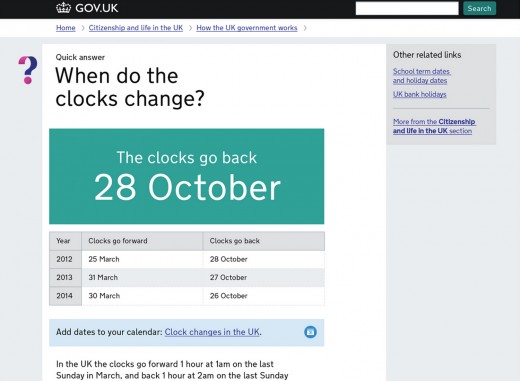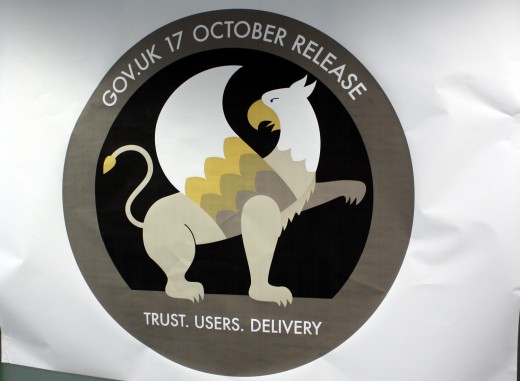
The UK Government is finally launching GOV.UK out of beta. From today this website replaces DirectGov and BusinessLink to consolidate the information that people need to get things done.
The idea is to create a ‘simpler, clearer and faster site’ and the changes have been in the works since the government’s digital champion, Martha Lane Fox, produced an online review of DirectGov in 2010.
It was clear at that time that digital services needed refreshing and redesigning. As Lane Fox pointed out, the original sites needed an overhaul to manage both the transactional services – like paying taxes and student loans, as well as being a place where all government information can be published and easily found.
The process of change on this scale is no mean feat. In February this year, the DirectGov site saw over 34 million visits; no pressure to get this one right then.
The Cabinet Office’s Government Digital Service (GDS) took on the work in a series of moves that would seem more familiar from a company like Amazon or Google, than a UK government department. The plans appear to be leaner and far more conservative when it comes to procurement and along the way, in an effort to keep the public informed, updates have been added to the GDS blog.
The process of getting the site right for users included an alpha phase in 2011 and the beta site, which was launched in February and ends today.
A quick look over the new site shows a cleaner design with more ways for people to find the information they need. Rather than having to search for Her Majesty’s Revenue and Customs (HMRC), clearer wording such as ‘tax’ in a search will surface relevant links.
Better still – the orange header has disappeared all together, take a look at the old DirectGov site below for reference:

Mindful language
Part of the process that has made information on the site better is the move to use common language to communicate. The words that government members use to speak to the public have been satirised from the times of ‘Yes Minister’ right through to ‘The Thick of It’.
Designing a policy around ‘non-automotive transport systems’ really does sound like crap when it’s referring to cycling. It’s not the language of people who pay taxes to governments and it shouldn’t happen in places where it is important to aim for clarity. So a move toward plain English is a welcome one.
Clean design
In a blog post added in July, GDS laid out ten principles for design. It was well received on many levels and even Tim O’Reilly, founder of O’Reilly Media, supported the principles via a comment on his Google+ account.
“These Digital Design Principles from the UK Gov are so good, I can only hope that everyone reads them, and follows them. Great design principles for commercial services as well as government services. If you’re in government, JFDI!”

Transactions will be the next phase and with existing legacy technologies still in place, this will be tricky while old contracts still stand. However, there is an alpha site running that is also helping to describe the changes as they come.
Open approach
Not only is the refresh about making a better user experience for people in the UK, there is also a move to provide consistency and openness in data. Some GDS code is available for others to use but the GDS prefers to refer to this as ‘Coding In The Open’ rather than Open Source.
Indeed the code is not strictly open source. There is a difference as not all of the code available would be useful to others, but the GDS says that the relevant parts are published under an MIT licence and there is also a github resource where developers can take a look.
The GDS has also been open about identity on the site. Slightly worrying articles about Facebook log-ins and the horror of a possible government database being carried through the site appeared this month but suppliers have yet to be announced.
A GDS blog post on the topic goes on to explain a little more, but the bottom line is that the Identity Assurance group has been working with experts like No2ID, Big Brother Watch, Which?, London School of Economics, Oxford Internet Institute and Privacy International to create the privacy principles for the site.
It also says “there’ll be no big IT programme and no big government database” but that “users will be able to prove who they are using accounts they already have with a wide range of non-government organisations.” It will be interesting to find out which those will be.
Keep Calm and Carry On
TNW dropped in to visit the GDS team at Aviation House in London last week. As the teams were on the cusp of launching a site to tens of millions of users, we might have expected a little more in the way of tension.
Quite the contrary. In an airy open office with walls coated in sticky notes and illustrations, a jovial but hard-working atmosphere was apparent. The work naturally doesn’t stop today with the site replacements and in reality there may be even more work to do as user feedback rolls in on a grand scale.
Mike Bracken, Executive Director of Digital at GDS is impressed with the way the work inspired others.
“What has been striking is the number of people who have approached us and said ‘I’ve seen what you are doing and I want to be a part of it’, and that’s a hugely gratifying position to be in.
We have recruited a number of people into GDS as full time civil servants, but have also done a lot of work with SME’s and asked them to come and join the team for a few weeks or months to help us deliver particular requirements.
I am very proud that we are part of the SME ecosystem in the UK – that’s a sentence it would probably been impossible for someone in government to say only 18 months ago.”

It seems that agile working practices for getting a better government service out to the public is a good idea. Indeed government can learn a lot more from businesses when it comes to working smarter and saving money.
In a progress report from the Cabinet Office earlier this year, it was stated that the total running costs for government websites was around £108 million for 2011-2012. The cost of running BusinessLink alone was £35 million per year.
The new GOV.UK portal is said to have a budget of just £1.7 million. That’s going to mean a lot of lean working and a few noses out of joint, as big businesses will no longer be able to bank on phenomenally priced government contracts.
Working in the cloud does seem to suit government practices. Last month GDS announced that cloud provider Skyscape is hosting the GOV.UK site, an infrastructure deal worth an estimated £600,000.
Huddle, the enterprise collaboration company now counts 70% of UK government departments on its books for organisation, management and people through the cloud.

All of this seems a lot more Tech City than Whitehall and maybe this should be the way things progress in the future. The proof will of course come as users get to know the new site, especially as it replaces DirectGov and BusinessLink.
Hopefully the ongoing work will provide a simpler, clearer and faster service that will be easy enough to get used to. But as with all changes to government services, there will be people who prefer the devil they know and will resist change even when the antiquated sites are truly a beast to work with.
Get the TNW newsletter
Get the most important tech news in your inbox each week.





